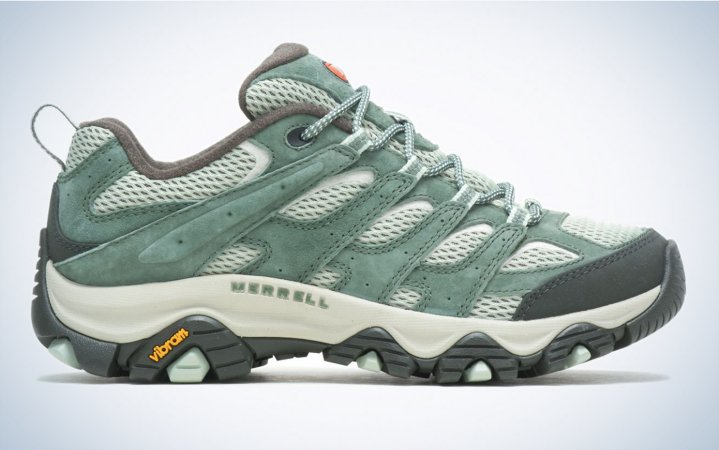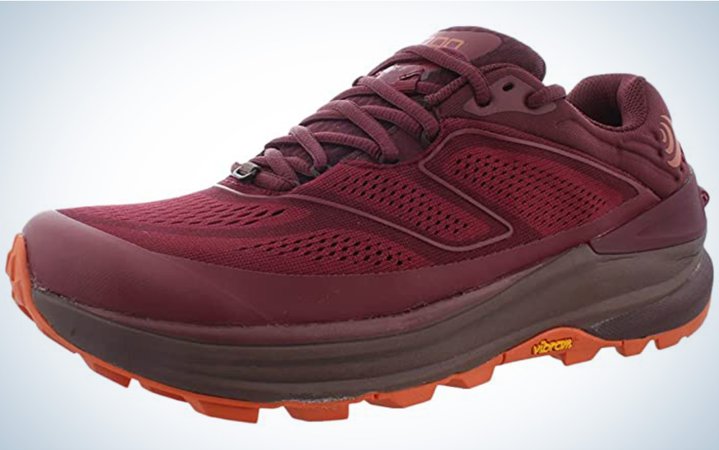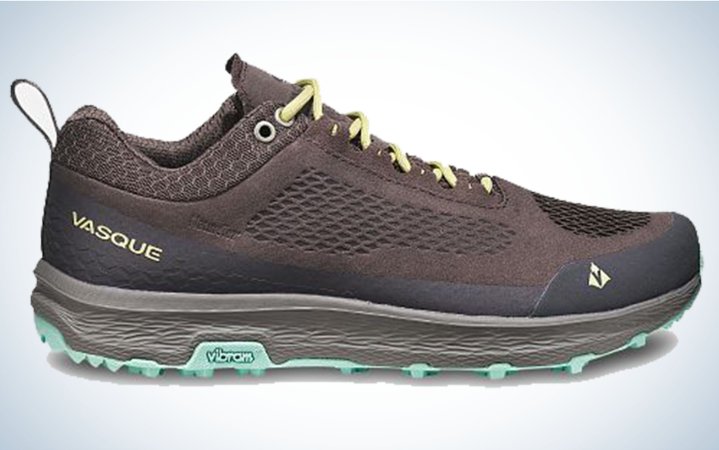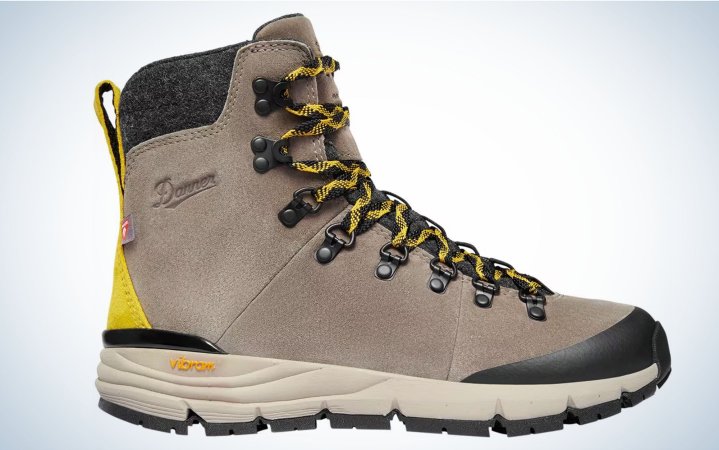We may earn revenue from the products available on this page and participate in affiliate programs. Learn More ›
Realistically, hiking shoes are whatever footwear you’re wearing while hiking. Many people take to the trails in whatever sneakers or hand-me-down boots are around the house. While this can take plenty of beginners pretty far (depending on the terrain) there’s no replacement for a good pair of women’s hiking shoes.
A shoe made for the kind of hiking you plan to do that fits your feet will help you fully enjoy your time outside. Hiking shoes are also sometimes a category all their own. They are lighter than hiking boots and don’t feature an ankle collar. They’re also heavier and more durable than trail runners or minimalist hiking shoes. However, we’ve compiled a list of a variety of hiking footwear that is best for women. This way you can find the best women’s hiking shoes that fit your foot, typical terrain, and hiking style.
- Best for Beginners: Merrell Moab 3
- Best Zero Drop: Altra Lone Peak 7
- Best Transition: Topo Ultraventure 2
- Best Hybrid: Danner Trail 2650 Campo GTX
- Best Minimalist Shoe: Vivobarefoot Primus Trail II FG
- Most Comfortable: Hoka Speedgoat 5
- Best Waterproof: Vasque Breeze
- Best Winter Hiking Boot: Danner Arctic 600
How We Tested the Best Women’s Hiking Shoes
OL staff writer, Laura Lancaster, and I have worn all of the shoes on this list on day hikes, multi-day backpacking trips, and thru-hiking. From minimalist shoes like the Vivobarefoot Primus Trail II FG to the best winter hiking boots like the Danner Arctic 600, we tested a variety of women’s hiking shoes to give you options tailored to your hiking style.
Best Women’s Hiking Shoes: Reviews & Recommendations
Best Overall: Merrell Moab 3
Best Overall
Merrell Moab 3
Key Features
- Weight: 1 pound 10 ounces
- Drop: 11.5mm
- Lug: 5mm
- Merrell Air Cushion heel
- Vibram TC5+ outsole
- 100 percent recycled laces and webbing
- Available in a waterproof version
Pros
- Comfortable
- Durable
- Good for wider feet
Cons
- Heavy
The Moab 3 provides excellent shock absorption and traction while keeping out debris. The Vibram outsole is stable but flexible enough for technical maneuvers. Deep lugs keep traction on anything from slick rock to sand, though fine sediment tends to cling on to the shoe. Though, the thick walls, high backs, and bellowed tongue keep the inside of the shoe free from pesky rocks, dirt, and brush. The upper mesh and laces also keep out unwanted debris even in deep sand.

Last year, I put the Moab 3s through three days of intense durability testing in their namesake location. Dreams of peeling outsoles, ripped mesh, and tearing seams danced in my head as I crawled through tight rocks, stemmed across keeper holes, and stomped through muck, but alas, I failed to destroy this budget beast of a shoe. Instead, I found myself grateful for the intense grip, protective toe, and stellar shock absorption. If the Moab’s held up in Moab, you can count on these in almost any terrain.
Read my full Merrel Moab 3 review to learn more.
Best Zero Drop: Altra Lone Peak 7
Best Zero Drop
Altra Lone Peak 7
Key Features
- Neutral support
- Less cushioned
- Heel Drop: 0mm
- Stack Height: 25mm at the heel
Pros
- Comparatively low stack height can help prevent ankle rolls
- Zero drop can help to strengthen feet (over time) and reduce knee issues
- Wide toe box and roomy sizing can help prevent blisters
Cons
- Can lead to injury if your feet, ankles, and calves are not sufficiently trained up
- Popularity on trail can give the impression that this is a good shoe for everyone
- Shorter life span than other picks on this list
Thru-hikers have been singing the praises of Altra Lone Peaks for years, and for good reasons. The Lone Peak is one of the most comfortable trail runners out there. Its wide base (especially the toe box) allows for foot growth and minimizes blisters. It also supports a midfoot or forefoot strike, with all the accompanying ergonomic benefits.

But the Altra Lone Peak is not the shoe for everyone. Its growing dominance on trail is leading to problems. Morgan Brosnihan, a doctor of physical therapy who primarily treats thru-hikers says, in large part due to its popularity, she sees people having more trouble with this shoe than any other. If you are a natural heel striker with limited ankle and toe flexibility, you should avoid this shoe. Start your hike with another trail runner on this list. Even if you do have the strike pattern and foot flexibility to take on this shoe, be sure to exercise your foot and lower legs in it heavily (with a loaded pack) before starting out on trail. Calf strength is essential to avoiding injuries with a shoe like the Altra Lone Peak.
Brosnihan also noted that the Altra Lone Peaks have a shorter life span than other trail runners out there. While several options on this list can make it out to 500 miles, this shoe is really only good for up to 300. The Altra Lone Peak Hiker features an ankle collar and won the most comfortable award in The Best Hiking Boots for Women. —Laura Lancaster
Read the Outdoor Life gear team’s review of the Altra Lone Peak 6 to learn more
Best Transition: Topo Ultraventure 2
Best Transition
Topo Ultraventure 3
Key Features
- Weight: Men’s: 20.8 ounces, Women’s: 16.6 ounces
- Stack Height: 25mm
- Heel-to-Toe Drop: 5mm
- Lug Height: 6mm
- Vibram XS Trek EVO rubber outsole
- Available in regular only
Pros
- Wide toebox
- Moderate cushion
- Great heel lock
Cons
- Durability in harsh terrain
- No wide option
This trail runner is the perfect bridge from a hiking boot to a lightweight hiking shoe. The wide toebox allows for excellent toe splay favoring stability and balance on rocky terrain. It breathes easy and the thick lugs and cushioning outsoles make for a an extremely comfortable trail runner out of the box. If you’re interested in a minimalist shoe, but concerned about making the jump, this shoe can also be a transition between a hybrid show like the Danner and a zero drop shoe like the Altra or Vivobarefoot. Its lower stack height and heel drop is just minimalist enough to ease your feet and gait into new footwear while the heel lock keeps you feeling secure. There is no wide option, but the toe box has a good amount of room.

If you’re frequenting talus fields or scree-filled slopes, you might run into durability issues. I did 100 miles above alpine in these shoes and came home to rip one on a dirt trail day hike. While I certainly put this shoe through the wringer, it was only 5 months old and in the vicinity of 200 miles. It shouldn’t have damage to the extent noticeable in the photo. However, the Topo team did replace my pair after the rip and the replacement is still my go-to shoe.
Best Hybrid: Danner Trail 2650 Campo GTX
Best Hybrid Hiking Shoes
Key Features
- Weight: Men’s: 24 ounces, Women’s: 19 ounces
- Stack Height: 32mm
- Heel-to-Toe Drop: 8mm
- Lug Height: 4mm
- Vibram 460 outsole
- Gore-Tex option
- Available in regular and wide
Pros
- Great fit
- Protects the foot like a traditional hiking shoe
- Fast break-in period
Cons
- Heavier than a typical trail runner
- Substantial heel-to-drop promotes heel striking
It can be tough to transition from the durability and secure fit of a heavier hiking boot or hiking shoe to lightweight trail runners, which aren’t always built for the heavy loads some backpackers carry. In preparation for an upcoming thru-hike, one tester took the Danner Trail Campo 2650 GTX on a series of day hikes that totaled fifty miles around Land Between the Lakes in Kentucky. She found that the integrated tongue of the shoe improved the overall fit, locking her heel into place and giving her the stability she was accustomed to from hiking shoes. Strategically placed leather panels on the upper also helped protect her toes and Achilles area, while the ventilation in the Gore-Tex kept her feet from overheating.
But they were more akin to trail runners when it came to comfort, “I did not have to break them in at all — they felt great on the first hike,” she reported. —Laura Lancaster
Best Minimalist: Vivobarefoot Primus Trail FG
Best Minimalist Hiking Shoes
Key Features
- Weight: Men’s: 18.4 ounces, Women’s: 15.7 ounces
- Stack Height: 6.5mm
- Heel-to-Toe Drop: None
- Lug Height: 4mm
- Firm ground outsole
- Available in regular only (although they run wide)
Pros
- Short stack height and zero heel drop make this a true barefoot shoe
- Durable lugs and reinforced upper
Cons
- The upper requires some break-in
- Does not provide as much ground feedback as others
Most minimalist trail runners are breezy, barely-there affairs, with only the thinnest membrane between your feet and the ground. And while that works well for low-key trail runs, the Vivobarefoot Primus FG can tackle more challenging backcountry conditions like slickrock, volcanic pumice, or the scorching desert floor at midday.

I wore these on a thru-hike of the Colorado Trail and was impressed by their durability. At the end of the trip, there were no holes in the upper and the seam at the feather edge was intact. While the lugs were worn to a nub at the forefoot, there were no significant signs of wear on the outsole itself. Despite being on the heavy side (although still substantially lighter than a standard trail runner), the Primus FG still performed like a minimalist shoe and promoted a mid-foot to forefoot strike that kept my foot low enough to the ground to negate any concerns of ankle roll. They also dried fast after stream crossings.
One word of caution is that this shoe should only be worn on the trail by people already accustomed to minimalist footwear, as an undeveloped arch is at risk of developing plantar fasciitis without the support of a standard trail runner or hiking shoe. —Laura Lancaster
Read Next: The Best Thru-Hiking Shoes of 2023
Most Comfortable: HOKA Speedgoat 5
Most Comfortable Hiking Shoes
Key Features
- Weight: Men’s: 20.6 ounces, Women’s: 17 ounces
- Stack Height: 32mm
- Heel-to-Toe Drop: 4mm
- Lug Height: 5mm
- Vibram Megagrip outsole
- Gore-Tex option
- Available in regular and wide
Pros
- Comfortable
- Improved stability from previous models
- Excellent traction in wet, slippery conditions
Cons
- Can feel heavy
- Narrow toe box doesn’t allow the foot to splay naturally
The substantial cushion on the Hoka Speedgoat 5 will catch your eye immediately. This feature makes this shoe the go-to for a wide range of people, from day hikers to trail runners to thru-hikers. But the stack height belies the mild heel-to-drop on this shoe, which promotes a mid-foot strike (as opposed to a heel strike), which lessens the impact on the rest of your body — especially if you’re carrying a heavy load down a steep trail.
Compared to previous versions of the Speedgoat, the 5s have slightly less cushion but are substantially more stable. An OL staff member noted that, in combination with the Vibram outsole and 5mm lugs, these shoes were excellent on their state’s varying terrain. Whether backpacking or or trail running, “from solid trail to steep skree fields … my foot felt secure and supported,” they said. —Laura Lancaster
Best Waterproof: Vasque Breeze
Vasque Breeze
best waterproof
Key Features
- Weight: 1 pound, 5 ounces
- Drop: 6mm
- Nature-Tex 50 percent post-consumer recycled waterproof membranes
- Anatomical high-rebound footbed
- Vibram Ground Control LiteBase with Megagrip Compound outsole
- Mesh upper is made of suede and 70 percent post-consumer recycled materials
Pros
- Stable
- Grippy
- Waterproof
Cons
- Narrow
- Stiff
With a narrow, snug fit, this low-drop shoe is great for hikers unwilling to sacrifice stability for less weight. The stiff style and uncompromising sole give the hiker control and confidence while still offering a light and breathable feel thanks to the mesh and thin suede upper. The waterproof technology is called Nature-Tex, utilizing 50 percent recycled materials. It is one of the most waterproof shoes I’ve ever worn with no leakage, even around the laces while submerged. I stood in a creek as deep as I could go without allowing water to flow over the ankle for a few minutes and my feet stayed completely dry.

While hiking I felt protected and secure in the Breeze LT NTX. The shoes only weigh 1 pound and 5 ounces, but they are designed to be durable and withstand the elements. These will certainly last a long time with proper care. If you prefer a hiking shoe that hugs every part of your foot, the Breeze is just right. While the Breeze is slender throughout, the tight space for your heel to fit caused a real problem by stiffly and aggressively rubbing the back of my foot
Read my full review of the Vasque Breeze LT NTX here
Best Winter Hiking Boot: Danner Arctic 600
Key Features
- Sizes: Men’s 7-14 (wide available); women’s 5-11
- Outsole: Vibram Nisqually Arctic Grip
- Insulation: 200g Primaloft Gold
- Danner Dry liner
Pros
- Best traction on ice in my test
- Very warm
- Side zip allows for easy on and off
Cons
- Side zip represents a point of failure
The Danner Arctic 600 performed exceptionally well on every test I threw at it. The Vibram Arctic Grip outsole (in combination with this shoe’s lug design) was extremely impressive. The stickiness of the traction meant I could barely tell I was walking on ice — it was almost impossible to slip with these shoes. Similarly this shoe stayed warmer than every other boot in my test while standing in the early spring runoff of the Middle Fork of the Snoqualmie River, and no moisture made its way into the boot. I did note, however, that this boot was the coldest at the side zipper.

The Danner Arctic 600’s side zipper was an unusual feature among the boots that I tried. While putting on and taking off boots seemingly every fifteen minutes, I appreciated that I could put on and remove these shoes without having to untie and retie the laces.

But as everyone who spends time outdoors knows, zippers represent a significant failure point on just about any piece of gear — and that goes double for waterproof zippers like those on the Arctic 600. If you are concerned about the long-term durability of the zipper (and I would be), consider not using this feature on a day-to-day basis.
Read Next: Best Hiking Shoes for Men
How to Choose the Best Women’s Hiking Shoes
Ankle Support
It turns out that the upper of a hiking boot does not help prevent ankle rolling — it’s actually the firmness of the base that does this. If you’re thinking about switching to a hiking shoe from a hiking boot, you can test this by trying to twist the base of the shoe. If it moves, it won’t provide as much ankle support.
Arch Support
On long hikes or backpacking trips, it’s common for the arch of the foot to become fatigued, which can lead to plantar fasciitis. A common cause of this, especially among day hikers and backpackers, is overpronation, where the foot leans or collapses inward. Anyone experiencing this, or suffering from pain while they walk might benefit from an insole like Superfeet (individuals with exceptionally strong arches may prefer a Currex insole).
Shoe Size
With hiking shoes, it’s important that there’s some space between your toes and the end of the shoe—aim for about a finger’s width of space between the end of your toes and the tip of the shoe. For most people, that will work to about a half size larger than they typically wear. However, Kelley cautions that many people, especially women, rely on shoe sizings that they received when they were younger, and don’t take into account the natural growth of the foot over time. Getting your foot sized by a professional—something you can do through REI’s Virtual Outfitting without visiting a store—is an important part of choosing a hiking shoe.
Traction
Traditionally, one of the most important differences between trail runners and hiking shoes was the size of the lugs. But today, there are a number of trail runners on the market with substantial lugs that mirror the functionality of traditional hiking shoes or boots.
Durability
One important difference between hiking shoes and trail runners is durability. Hiking shoes typically last for 500 to 700 miles, while trail runners only last 300 to 500 miles. Factors that can affect this include the durability of the rubber, the sole, the midsole, and the uppers (leather vs. mesh), as well as the weight of the person wearing the shoes and the conditions they frequent. —Laura Lancaster
FAQs
Buying a pair of the best women’s hiking shoes is a good way to avoid foot pain while hiking. Try on multiple pairs and walk around in them, test them on inclines and other uneven surfaces. If you’re still having foot pain, one of the best insoles for hiking could help. Sometimes it is also wise to buy a half to a whole size up from your normal shoe size as intense activity like hiking can make your feet swell.
Yes. Hiking shoes are great for walking if you’re looking for extra support and durability. However, keep in mind that this will wear out your hiking shoes faster.
Sometimes, yes, but not all running shoes are the same. Trail runners are frequently used for hiking and backpacking. They’re made for trails and can typically handle the terrain. Plenty of hikers and backpackers opt for trail runners as their go-to hiking shoe. Running shoes designed for a track or pavement are just fine for plenty of hikes, but it may not provide the traction and durability necessary for slick or very uneven terrain. These shoes won’t protect your foot as well from rocks or rain, and it will wear out much faster than one of the shoes on this list.
Final Thoughts
The best women’s hiking shoes can help you hike farther, more comfortably. From winter boots to minimalist shoes, there’s a variety of quality hiking shoes to choose from. You should always try on shoes if possible before committing to wearing them on a long hike. Some of the women’s hiking shoes on this list are comfortable out of the box like the Merrel Moab 3 and others will need to be broken in like the Vasque Breeze. But there’s a hiking shoe for you on this list:
- Best for Beginners: Merrell Moab 3
- Best Zero Drop: Altra Lone Peak 7
- Best Transition: Topo Ultraventure 2
- Best Hybrid: Danner Trail 2650 Campo GTX
- Best Minimalist Shoe: Vivobarefoot Primus Trail II FG
- Most Comfortable: Hoka Speedgoat 5
- Best Waterproof: Vasque Breeze
- Best Winter Hiking Boot: Danner Arctic 600











